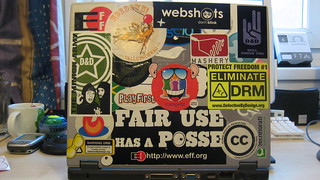
Speaker: Brandon Butler (Peter Jaszi was absent)
The purpose of copyright is to promote the creation of culture. It is not to ensure that authors get a steady stream of income no matter what, or to pay them back for the hard work they do, or to show our respect for the value they add to society. It’s about getting the stuff into the culture, and giving the creators enough incentive to do it.
One way it does it is to give creators exclusive rights for a limited period of time. The limit encourages new makers to use and remix existing culture.
Fair use is the biggest balancing feature of copyright. It ensures that the rights provided to the creators don’t become oppressive to the users. Fair use is the legal, unauthorized use of copyrighted material… under some circumstances. And we’ve spent generations trying to figure out which circumstances apply.
Fair use is a space for creativity. It gives you the leeway to take the culture around you and incorporate it into your work. It allows you to quote other scholarship in your research. It allows you to incorporate art into new works.
There are four factors of fair use. Every judge should consider the reason for the use, the kind of work used, the amount used, and the effect on the market. But it doesn’t tell the judges how much to consider or which is more important. The good news is that judges love balancing features, and the Supreme Court has determined that fair use protects free speech. However, since copyright is automatically conferred as soon as the creation is fixed, the fair use judicial interpretations have shifted greatly since 1990 to be more in the balance of the users in certain circumstances.
Without fair use, copyright would be in conflict with the 1st Amendment.
Judges want to know if the use is transformative (i.e. for a new purpose, context, audience, insight) and if you used the right amount in that transformative process. For example, parody is making fun of the original work, not just reusing it. An appropriate amount can refer to both the quantity of the original in the transformative work, and also the audience who received your transformative work. For example, the many photographic memes that take pictures and alter them to fit a theme, like One Tiny Hand.
Judges care about you and what you think is fair. There is a pattern of judges deferring to the well-articulated norms of a practice community.
Best practices codes are a logical outgrowth of the things the communities have articulated as their values and the things they would consider to be legitimate transformative works. Documentary filmmakers, scholars, media literacy teachers, online video, dance collections, open course ware, poets… many groups are creating best practices for fair use.
The documentary filmmakers have had a code of best practice for a long time. They realized that without it, they were limiting themselves too much in what they could create. Once they codified their values, more broadcast sources were willing to take films and new kinds of films were being made. Insurers of errors and omissions insurance were able to accept fair use claims, and lawyers use the Statement to build their own best practices in the relevant areas.
Keep in mind, though, that these are best practices and not guidelines. Principles, not rules. Limitations, not bans. Reasoning, not rote. The numerical limits we once followed are not the law, and we need to keep them fresh to be relevant.
Licensing is a different thing all together. This means you may have less rights in some instances, and more rights in others, regardless of fair use.
For libraries, fair use enables our mission to serve knowledge past, present, and future. We have a duty to make copyrighted works real and accessible in the way people use things now. What will libraries be in the future? How will we stay relevant? We need to have some flexibility with the stuff we have in our collections.
Many librarians are discouraged. Insecurity and hesitation equal staff costs to hire someone to clear copyright questions. Fair use would help, but it’s underused. Risk aversion subsumes fair use analysis.
The ARL document took a lot of people from diverse institutions and many hours of discussion to create it, and it was reviewed by several legal experts. It’s not risk-free, since it would need to stand up in court first (and there are always lawsuit-happy people), but it seems okay based on past judgement.
They hope it will put legal risks into perspective, and will give librarians a tool to go to general counsels and administrations and let them know things are changing. It considered the views of librarians and their values, and they also hope that people will speak out publicly that they support the Code.
Fair use applies in these common situtations:
- course reserves — digital access to teaching materials for students and faculty, although it should be limited to access by only the appropriate audience
- both physical and virtual exhibits — if it highlights a theme or commonality, you’re doing something new to help people understand what’s in your library
- digitizing to preserve at-risk items — you’re not a publisher or scam artist, you’re a librarian making sure the things are accessible over time (like VHS tapes)
- digitizing special collections and archives — you’re keeping it alive
- access to research and teaching materials for disabled users — i.e. Daisy
- institutional repositories
- creation of search indexes
- making topically-based collections of web-based materials
Practice makes practice. It won’t work if you don’t use it.
